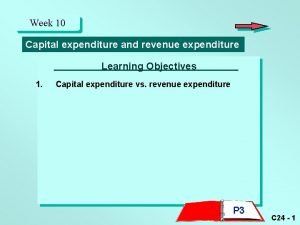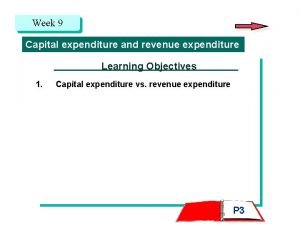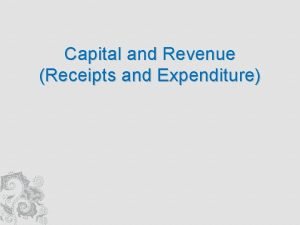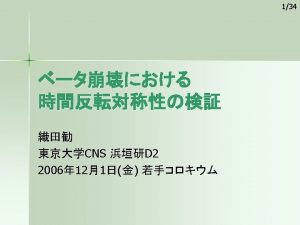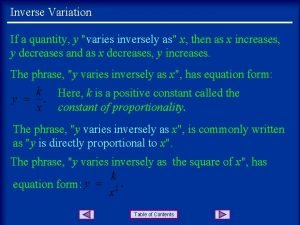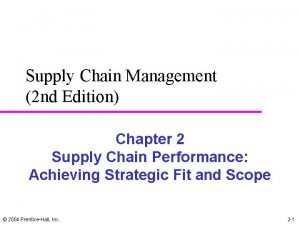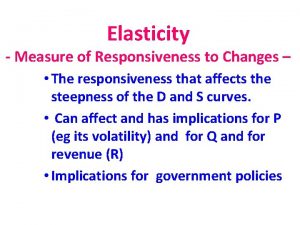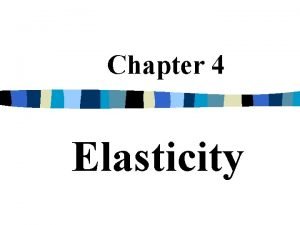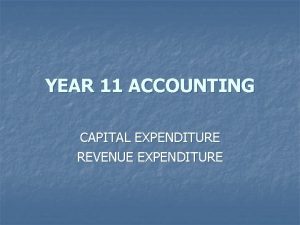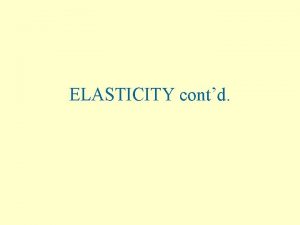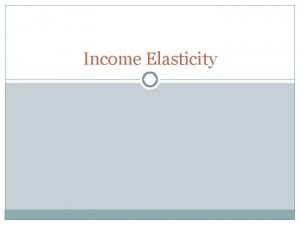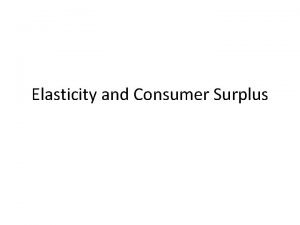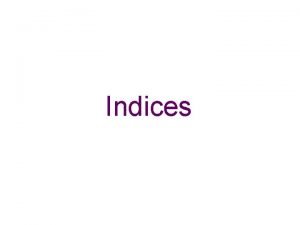Elasticity and Expenditure Definitions Elasticity responsiveness of quantity



















- Slides: 19

Elasticity and Expenditure

Definitions • Elasticity = responsiveness of quantity demanded to price. • Coefficient of elasticity = Percent change in quantity Percent change in price • Percent change in Q = Change in Q / Q = Q 2 - Q 1 divided by Q 1 • Percent change in P = Change in P / P = P 2 - P 1 divided by P 1

Relationship to expenditure • % Δ (PQ) = % Δ P + % Δ Q • If % Δ P = 3 percent and % Δ Q = -10 % , then % Δ (PQ) = - 7 % or revenue declines • Coef of elas = ε = % Δ Q divided by % Δ P hence in the above example ε = 10 / 3 = 3. 33 The coefficient of elasticity is greater than 1, so demand is ELASTIC

Problem: % Δ Q = - 10 %, and % Δ P = 4 % a. what is the coefficient of elasticity? b. is demand elastic or inelastic? c. what is the percent change in consumer expenditure? [See next slide for answers…but not before trying to solve the problem]

Solution: % Δ Q = - 10 %, and % Δ P = 4 % a. what is the coefficient of elasticity? ε = % Δ Q / % Δ P = 10 / 4 = 2. 5 b. is demand elastic or inelastic? -- since ε > 1. 0, demand is elastic. We should expect that consumer expenditure will decline with an increase in price. c. what is the percent change in consumer expenditure? Since % Δ PQ = % Δ P + % Δ Q, we have % Δ PQ = 4 % - 10 % = - 6 %

Problem: % Δ Q = + 10 %, and % Δ Revenue = 3 % a. what is the percent change in price? b. what is the coefficient of elasticity? c. is demand elastic or inelastic? d. what is the percent change in consumer expenditure? [See next slide for answers…but not before trying to solve the problem]

Solution: % Δ Q = + 10 %, and % Δ Revenue = + 3 % a. what is the percent change in price? Since % Δ PQ = % Δ P + % Δ Q 3 % = % Δ P + 10 % Price must have fallen by 7 percent b. what is the coefficient of elasticity? Since ε = % Δ Q / % Δ P = 10 % / 7 % = 1. 43 c. is demand elastic or inelastic? Elastic demand – a reduction in price leads to an increase in revenue -- the coefficient of elasticity is greater than 1. d. what is the percent change in consumer expenditure? The same as the percent change in revenue, + 3 %

Problem: % Δ P = + 10 %, and % Δ Revenue = - 3 % a. what is the percent change in quantity? b. what is the coefficient of elasticity? c. is demand elastic or inelastic? d. what is the percent change in consumer expenditure? [See next slide for answers…but not before trying to solve the problem]

Solution: % Δ Q = + 10 %, and % Δ Revenue = - 3 % a. what is the percent change in price? Since % Δ PQ = % Δ P + % Δ Q - 3 % = % Δ P + 10 % Price must have fallen by 13 percent b. what is the coefficient of elasticity? Since ε = % Δ Q / % Δ P = 10 % / 13 % = c. is demand elastic or inelastic? Inelastic demand – a reduction in price leads to a decrease in revenue -- the coefficient of elasticity is less than 1. d. what is the percent change in consumer expenditure? The same as the percent change in revenue, - 3 %

Problem: % Δ P = + 10 %, and ε = 2. 5 a. what is the percent change in quantity? b. is demand elastic or inelastic? c. what is the percent change in consumer expenditure? [See next slide for answers…but not before trying to solve the problem]

Solution: % Δ P = + 10 %, and ε = 2. 5 a. what is the percent change in quantity? Since ε = 2. 5 = % Δ Q / % Δ P = % Δ Q / 10 We have % Δ Q = - 25 % (when price goes up, Q down) b. is demand elastic or inelastic? Since ε = 2. 5, demand is ELASTIC; we should expect consumer expenditure to decrease when price increases. c. what is the percent change in consumer expenditure? Since % Δ PQ = % Δ P + % Δ Q, we have % Δ PQ = + 10 - 25 % = - 15%

Problem: % Δ P = + 5 %, and ε = 1/4 a. what is the percent change in quantity? b. is demand elastic or inelastic? c. what is the percent change in consumer expenditure? [See next slide for answers…but not before trying to solve the problem]

Solution: % Δ P = + 5 %, and ε = ¼ a. what is the percent change in quantity? Since ε = ¼ = % Δ Q / % Δ P = % Δ Q / 5 We have % Δ Q = - 1. 25 % (when price goes up, Q down) b. is demand elastic or inelastic? Since ε = ¼ , demand is INELASTIC; we should expect consumer expenditure to increase when price increases. c. what is the percent change in consumer expenditure? Since % Δ PQ = % Δ P + % Δ Q, we have % Δ PQ = + 5 % - 1. 25 % = + 3. 75%

Calculating elasticity from a table Price Quantity % Δ P 1 180 2 160 3 140 4 120 5 100 %ΔQ Elasticity

Calculating elasticity from a table Price Quantity % Δ P %ΔQ Elasticity 1 180 20 / 180 = 11. 1 % 20 / 160 = 12. 5 % 20 / 140 = 14. 3 % 20 / 120 = 16. 7% 20 / 100 = 20 % 0. 111 2 3 4 5 160 140 120 100 2– 1/1 = 100 % 3– 2/2 = 50 % 4– 3/3 = 33 % 5– 4/4 = 25 % 6– 5/5 = 20 % (inelastic) 0. 25 (inelastic) 0. 43 (inelastic) 0. 67 (inelastic) 1. 00 (unit elastic)

Elasticity and slope The table was derived from the demand equation: Q = 200 - 20 P Note that for each dollar price goes up, Q goes down by 20 units. In mathematical symbolism, Δ Q / Δ P = - 20 This is close to the formula for the coefficient of elasticity, but not quite the same. What is the difference? [Pause for thought…]

Elasticity and slope Slope = Δ Q / Δ P = - 20 But coefficient of elasticity = Δ Q / Q divided by Δ P / P The expression for the coefficient of elastictity can be rearranged to get ε = Δ Q / Δ P times P / Q Which can be a handy computational rule for elasticity AT a point.

Problem: given the demand equation Q = 1500 – 25 P What is the coefficient of elasticity at: P = 10 ? First note that Q = 1500 – 250 = 1250, So that the coefficient of elasticity is: ε = Δ Q / Δ P times P / Q ε = 25 (10) / 1250 = 250 / 1250 ε = 0. 20

Problem: given the demand equation Q = 1500 – 25 P What is the coefficient of elasticity at: P = 50 ? First note that Q = 1500 – 1250 = 250, So that the coefficient of elasticity is: ε = Δ Q / Δ P times P / Q ε = 25 (50 / 250) = 1250 / 250 ε = 5. 0
 Capital expenditure and revenue expenditure
Capital expenditure and revenue expenditure Revenue expenditure examples
Revenue expenditure examples Revenue expenditure vs capital expenditure
Revenue expenditure vs capital expenditure Capital expenditure and revenue expenditure
Capital expenditure and revenue expenditure Example of a vector quantity?
Example of a vector quantity? What is vector quantity
What is vector quantity What are scalar and vector quantities
What are scalar and vector quantities Polar and axial vector pdf
Polar and axial vector pdf Y varies inversely as x example
Y varies inversely as x example Communication styles driver analytical amiable expressive
Communication styles driver analytical amiable expressive Cost pressures and pressures for local responsiveness
Cost pressures and pressures for local responsiveness Hotstuff bft
Hotstuff bft Brief-sr
Brief-sr Cost-responsiveness efficient frontier
Cost-responsiveness efficient frontier Social responsiveness
Social responsiveness Integration responsiveness grid
Integration responsiveness grid Intrafunctional scope
Intrafunctional scope Integration responsiveness grid
Integration responsiveness grid Cost responsiveness efficient frontier
Cost responsiveness efficient frontier Cost-responsiveness efficient frontier
Cost-responsiveness efficient frontier
